SUMMARY CMI
BUDENOFALK® foam
Consumer Medicine Information (CMI) summary
The full CMI on the next page has more details. If you are worried about using this medicine, speak to your doctor or pharmacist.
1. Why am I using BUDENOFALK foam?
BUDENOFALK foam contains the active ingredient, budesonide. BUDENOFALK foam is used to treat ulcerative colitis (inflammation) of the rectum (back passage) and the lower part of the large bowel.
For more information, see Section 1. Why am I using BUDENOFALK foam? in the full CMI.
2. What should I know before I use BUDENOFALK foam?
Do not use if you have ever had an allergic reaction to BUDENOFALK foam or any of the ingredients listed at the end of the CMI.
Talk to your doctor if you have any other medical conditions, take any other medicines, or are pregnant or plan to become pregnant or are breastfeeding.
For more information, see Section 2. What should I know before I use BUDENOFALK foam? in the full CMI.
3. What if I am taking other medicines?
Some medicines may interfere with BUDENOFALK foam and affect how it works.
A list of these medicines is in Section 3. What if I am taking other medicines? in the full CMI.
4. How do I use BUDENOFALK foam?
The recommended dose is one actuation daily, corresponding to 2 mg budesonide. BUDENOFALK foam can be applied in the morning or evening.
This medicine may only be used rectally, so it has to be inserted through the anus. Do NOT take it by mouth.
More instructions can be found in Section 4. How do I use BUDENOFALK foam? in the full CMI.
5. What should I know while using BUDENOFALK foam?
| Things you should do |
|
| Things you should not do |
|
| Driving or using machines |
|
| Looking after your medicine |
|
For more information, see Section 5. What should I know while using BUDENOFALK foam? in the full CMI.
6. Are there any side effects?
All medicines can have side effects. If they do occur, they are usually minor and temporary. The most common side effects using BUDENOFALK foam are: Burning or pain in the rectum, indigestion, irritable stomach (dyspepsia), increased risk of infection, muscle and joint pain, muscle weakness, muscle twitching, brittle bones (osteoporosis), mood changes, such as depression, irritability or euphoria.
For more information, including what to do if you have any side effects, see Section 6. Are there any side effects? in the full CMI.
FULL CMI
BUDENOFALK® foam
Active ingredient: budesonide
Consumer Medicine Information (CMI)
This leaflet provides important information about using BUDENOFALK foam. You should also speak to your doctor or pharmacist if you would like further information or if you have any concerns or questions about using BUDENOFALK foam.
Where to find information in this leaflet:
1. Why am I using BUDENOFALK foam?
2. What should I know before I use BUDENOFALK foam?
3. What if I am taking other medicines?
4. How do I use BUDENOFALK foam?
5. What should I know while using BUDENOFALK foam?
6. Are there any side effects?
7. Product details
1. Why am I using BUDENOFALK foam?
BUDENOFALK foam contains the active ingredient, budesonide. Budesonide belongs to a group of medications called corticosteroids.
BUDENOFALK foam is used to treat ulcerative colitis (inflammation) of the rectum (back passage) and the lower part of the large bowel.
2. What should I know before I use BUDENOFALK foam?
Warnings
Do not use BUDENOFALK foam if:
- you are allergic to budesonide, or any of the ingredients listed at the end of this leaflet.
- Always check the ingredients to make sure you can use this medicine.
- Do not use this medicine if you suffer from a severe liver disease (liver cirrhosis).
- Do not use this medicine after the expiry date printed on the pack or if the packaging is torn or shows signs of tampering when it is dispensed to you.
Check with your doctor if you:
- Tell your doctor if you have any other conditions and taking medicines
- liver disease
- lung disease (tuberculosis)
- high blood pressure
- diabetes, when the level of sugar in the blood is too high
- disease which causes bones to become less dense, gradually making them weaker, more brittle and likely to break (osteoporosis)
- ulcer in stomach or duodenum
- glaucoma (high pressure in the eye)
- cataracts
- family history of diabetes or glaucoma
- any stresses
- any other disease where use of corticosteroids may have unwanted effects. - you have an infection. The symptoms of some infections can be atypical or less pronounced.
- have been exposed to chicken pox, measles or shingles infections. These illnesses may become more severe when you take BUDENOFALK.
- have not yet had measles.
- need to be vaccinated, please speak to your doctor first.
- are due to have an operation, please tell your surgeon and anaesthetist that you are using BUDENOFALK foam.
- have been treated with a systemically acting corticosteroid preparation (i.e. one which is absorbed into the blood circulation and acting outside the gastrointestinal tract) before starting treatment with BUDENOFALK foam, your symptoms may reappear when the medicine is changed. If this happens, contact your doctor.
- experience blurred vision or other visual disturbances.
There is insufficient information to recommend BUDENOFALK foam for use in children or adolescents.
BUDENOFALK foam contains propylene glycol which may cause skin irritation in some people.
BUDENOFALK foam also contains cetyl alcohol and cetostearyl alcohol (component of emulsifying wax), which may cause local skin reactions (e.g. contact dermatitis).
During treatment, you may be at risk of developing certain side effects. It is important you understand these risks and how to monitor for them. See additional information under Section 6. Are there any side effects?
Pregnancy and breastfeeding
Check with your doctor if you are pregnant or intend to become pregnant.
Talk to your doctor if you are breastfeeding or intend to breastfeed.
Your doctor will discuss the risks and benefits of using BUDENOFALK foam if you are pregnant or breastfeeding.
3. What if I am taking other medicines?
Tell your doctor or pharmacist if you are taking any other medicines, including any medicines, vitamins or supplements that you buy without a prescription from your pharmacy, supermarket or health food shop.
Some medicines may interfere with BUDENOFALK foam and affect how it works.
- cardiac glycosides such as digoxin, medicines used to treat heart conditions
- diuretics, medicines used to treat excess fluid in your body
- ketoconazole and itraconazole, medicines used to treat fungal infections
- antibiotics such as clarithromycin and rifampicin, medicines used to treat infections
- ritonavir and cobicistat medicines used for treating HIV infections
- carbamazepine, medicine used for treating epilepsy
- rifampicin, medicine used to treat tuberculosis
- contraceptive pill
- cholestyramine, medicine used to reduce cholesterol level
- cimetidine, medicine to reduce stomach acid.
These medicines may be affected by BUDENOFALK foam or they may affect how well BUDENOFALK foam works. You may need different doses of your medicines or you may need to take different medicines. Your doctor or pharmacist will advise you if this is required.
Avoid drinking grapefruit juice while you are using BUDENOFALK foam as this can alter its effects.
Your doctor or pharmacist have more information on medicines to be careful with or to avoid while using BUDENOFALK foam.
Check with your doctor or pharmacist if you are not sure about what medicines, vitamins or supplements you are using and if these affect BUDENOFALK foam.
4. How do I use BUDENOFALK foam?
How much to use
Follow all directions given to you by your doctor or pharmacist carefully.
They may differ from the information contained in this leaflet.
Adults and the elderly: Apply one actuation daily, corresponding to 2 mg budesonide. BUDENOFALK foam can be used in the morning or evening.
One BUDENOFALK foam contains 14 doses (14 applications or “actuations”) or 2 weeks of dosing, based on a standard 2 mg/day dosing regimen.
In the product pack, the individual applicators are inserted into purpose-designed plastic tray. To remove an applicator, push down firmly on the tray with one hand, while pulling out the applicator with the other hand.
When to use
BUDENOFALK foam should be administered about the same time each day. Using it at the same time each day will have the best effect. It will help you remember when to use it.
How to use
Picture of the can

This medicine may only be used rectally, so it has to be inserted via the anus. Do NOT take it by mouth.
If possible, go to the toilet and empty your bowels before using the foam.
- Wash your hands thoroughly with soap and water.
- For your comfort, ensure that BUDENOFALK foam should always be stored at room temperature before use.
- Push the applicator firmly onto the spout of the spray can.
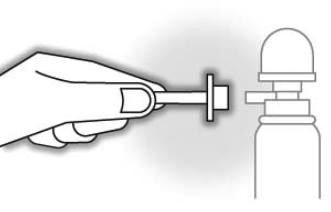
- Shake the can for 15 seconds to mix the contents.
- Each time you use a new can, remove the safety tab from under the pump dome.
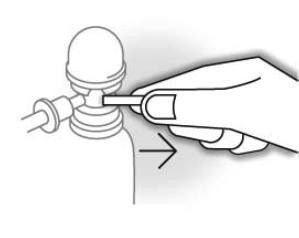
- Twist the dome on top of the canister until the semi-circular gap underneath it is in line with the applicator.
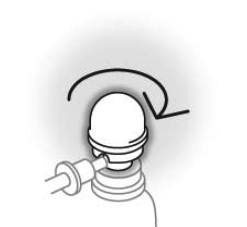
The can is now ready for use.
- Place your forefinger on top of the pump dome. Turn the can upside down. Note that the can will only work properly when held with the pump dome pointing down and as vertically as possible.
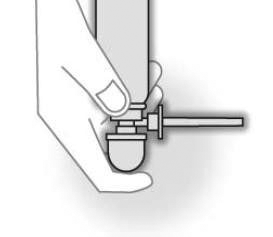
- Place one foot on a stool or chair. Alternatively, lie on your side with the lower leg stretched out and the upper leg bent at an angle.
- Insert the applicator into the rectum as far as possible. Push down the pump dome fully once, hold and then release it very slowly. As soon as you release the pump dome, the foam will be actuated from the can. Leave the applicator in this position for 10 to 15 seconds before withdrawing it from your rectum to allow the full dose to be released.
This will ensure that the entire dose is delivered to the rectum and will also reduce the risk any irritation around your anus if the applicator is removed too quickly while the foam is still being released.
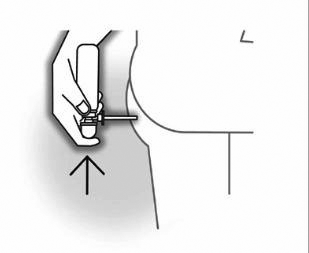
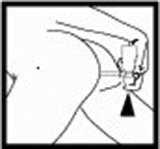
- After administering the foam remove the applicator from the spout of the can and dispose of it as domestic waste in the plastic bag provided.
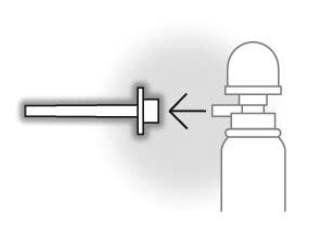
- Wash your hands thoroughly and try not to empty your bowels again for as long as possible.
- Always use a new applicator for each dose.
You may experience a little discomfort and a feeling of urgency to empty your bowels immediately after foam insertion. This is normal and expected, especially when you first start using BUDENOFALK foam due to the inflammation present within the bowel related to your ulcerative colitis. Try to resist this urge to empty your bowels for as long as possible. This feeling will subside over the next few days as treatment continues and the inflammation decreases.
The following QR code links to a patient instructions for use video, which covers the same dosing procedure detailed above:

How long to use
The duration of treatment will be decided by your doctor. In general, the inflammation and associated symptoms should subside after 6 to 8 weeks.
BUDENOFALK helps control your condition but does not cure it. Therefore, you must continue to use BUDENOFALK for as long as your doctor tells you to.
If you forget to use
If you missed a dose and it is almost time for your next dose, skip the dose you missed and administer your next dose when you are meant to.
Otherwise, dose as soon as you can and then go back to taking your medicine at the time in the day you would normally administer it.
Do not use a double dose to make up for the dose that you missed.
If you are not sure what to do, ask your doctor or pharmacist.
If you have trouble remembering when to use your medicine, ask your pharmacist for some hints.
If you use too much
To date, no cases of overdosage with budesonide are known. In view of the properties of budesonide contained in BUDENOFALK foam, an overdose resulting in toxic damage is extremely unlikely.
For information on the management of overdose, contact the Poisons Information Centre on 13 11 26 (Australia).
5. What should I know while using BUDENOFALK foam?
Things you should do
If you are about to start on any new medicine, remind your doctor and pharmacist that you are also using BUDENOFALK foam.
Tell any other doctors, dentists, and pharmacists who treat you that you are using this medicine.
If you are going to have surgery, tell the surgeon or anaesthetist that you are using BUDENOFALK foam.
It may affect other medicines used during surgery.
If you become pregnant while using this medicine, tell your doctor immediately.
Things you should not do
Do not use BUDENOFALK foam to treat any other complaints unless your doctor tells you to.
Do not give your medicine to anyone else, even if they have the same condition as you.
Do not stop using BUDENOFALK foam or change the dosage without checking with your doctor.
Driving or using machines
This medicine is not expected to affect your ability to drive a car or operate machinery.
Looking after your medicine
Keep BUDENOFALK foam in its original packaging until it is time to use it.
Keep your BUDENOFALK foam in a cool place where the temperature stays below 25°C.
Store the pack upright.
Do not refrigerate or freeze.
Protect from direct sunlight.
Keep away from flames or sparks. Contains flammable gas.
Use within 4 weeks of first opening.
Do not store BUDENOFALK foam or any other medicine in the bathroom or near a sink. Do not leave it on a windowsill or in the car.
Heat and dampness can destroy some medicines.
Keep it where children cannot reach it.
A locked cupboard at least one-and-a-half metres above the ground is a good place to store medicines.
Getting rid of any unwanted medicine
If you no longer need to use this medicine or it is out of date, take it to any pharmacy for safe disposal.
Do not use this medicine after the expiry date.
Do not pierce or burn the can even when empty.
6. Are there any side effects?
All medicines can have side effects. If you do experience any side effects, most of them are minor and temporary. However, some side effects may need medical attention.
See the information below and, if you need to, speak to your doctor or pharmacist if you have any further questions about side effects.
Less serious side effects
| Less serious side effects | What to do |
| When using BUDENOFALK foam: Common side effects:
| Speak to your doctor if you have any of these less serious side effects and they worry you. |
Serious side effect
| Serious side effects | What to do |
| Call your doctor or pharmacist immediately if you notice any of these symptoms. |
The following side effects have been reported with medicines which are in the same class as BUENDOFALK foam (corticosteroids). These side effects are typical for systematically acting preparations (i.e. absorbed into the blood circulation and acting outside the gastrointestinal tract). As BUDENOFALK foam acts locally, the risk of these class effects occurring with this medicine is generally expected to be lower than with the systemically acting corticosteroids.
Possible class effects of systemically acting corticosteroids are:
- Cushing's syndrome – e.g. with roundness of the face, weight gain, reduced glucose tolerance, high blood sugar, high blood pressure, fluid retention in the tissues (e.g. swollen legs), increased excretion of potassium (hypokalaemia), irregular periods in women, unwanted body hair in women, impotence, abnormal laboratory findings (reduced adrenal function), red stripes on the skin (stretch marks), acne.
- increased risk of infection
- mood changes such as depression, irritation or euphoria
- Tiredness, malaise
- blurred vision (e.g. glaucoma and cataract)
- increased risk of blood clotting, disease of the blood vessels (associated with stopping steroid use after long term therapy)
- stomach complaints, gastric ulcers, pancreatitis and constipation
- muscle pain and bone weakness (osteoporosis), loss of bone and cartilage (aseptic bone necrosis)
- rash from hypersensitivity reactions (allergic exanthema), formation of red stripes (striations) and bleeding in the skin, delayed wound healing, local skin reactions (such as contact dermatitis)
- isolated cases: increased brain pressure with possible additional swelling of the optic disk in adolescents.
Some of these unwanted effects were only reported after long-term use of oral budesonide.
These side effects are typical for systemic corticosteroids. Data shows that the frequency of systemic adverse reactions is lower with BUDENOFALK foam due to its local action.
Tell your doctor or pharmacist if you notice anything else that may be making you feel unwell.
Other side effects not listed here may occur in some people.
Reporting side effects
After you have received medical advice for any side effects you experience, you can report side effects to the Therapeutic Goods Administration online at www.tga.gov.au/reporting-problems. By reporting side effects, you can help provide more information on the safety of this medicine.
Always make sure you speak to your doctor or pharmacist before you decide to stop using any of your medicines.
7. Product details
This medicine is only available with a doctor's prescription.
What BUDENOFALK foam contains
| Active ingredient (main ingredient) | Budesonide 2 mg |
| Other ingredients (inactive ingredients) | emulsifying wax cetyl alcohol purified water disodium edetate steareth-10 propylene glycol citric acid monohydrate, butane, isobutane and propane as propellants. |
Do not use this medicine if you are allergic to any of these ingredients.
After administration of 14 spray actuations (14 daily doses), a residual amount of foam will remain in the can. This is present in the can to ensure that 2 mg of budesonide is contained in all 14 doses. Throw away the can with any residual contents after application of the 14 daily doses.
What BUDENOFALK foam looks like
BUDENOFALK foam available in the following packs:
- Two pressurised containers (14 daily doses each can), with 28 applicators and 28 plastic bags.
Who distributes BUDENOFALK foam
Dr Falk Pharma Australia Pty Ltd,
9 Help Street
Chatswood, NSW 2067
Australian Registration Number: AUST R 179575
BUDENOFALK® is a registered trademark of Dr. Falk Pharma GmbH, Germany.
This leaflet was prepared in February 2025.
Published by MIMS May 2025

 Undesirable effects were reported in 14% of patients in clinical trials with Budenofalk foam. Burning in the rectum or pain were common, and nausea, headache and an increase in liver enzymes were uncommon.
Undesirable effects were reported in 14% of patients in clinical trials with Budenofalk foam. Burning in the rectum or pain were common, and nausea, headache and an increase in liver enzymes were uncommon.
 Scintigraphic study of a single rectal dose of 99mTc labelled budesonide 2 mg (Budenofalk) foam in 12 patients showed that the spread of the budesonide foam ranged between 11 and 40 cm (mean of 25.4 ± 10.3 cm) from the anal verge, depending on the individual patient (this range includes extending to the distal half of the sigmoid colon, and to the proximal third of the descending colon). The maximal spread was reached between 2 and 6 hours (mean of 4 hours) after dosing, depending on the individual patient and remained relatively stable for between 4 hours and 6 hours. The distal half of the sigmoid colon was reached in all patients approximately after 2 hours after dosing and accounted for 27.4% of the administered radiolabelled budesonide foam.
Scintigraphic study of a single rectal dose of 99mTc labelled budesonide 2 mg (Budenofalk) foam in 12 patients showed that the spread of the budesonide foam ranged between 11 and 40 cm (mean of 25.4 ± 10.3 cm) from the anal verge, depending on the individual patient (this range includes extending to the distal half of the sigmoid colon, and to the proximal third of the descending colon). The maximal spread was reached between 2 and 6 hours (mean of 4 hours) after dosing, depending on the individual patient and remained relatively stable for between 4 hours and 6 hours. The distal half of the sigmoid colon was reached in all patients approximately after 2 hours after dosing and accounted for 27.4% of the administered radiolabelled budesonide foam. Chemical name: 16α,17α-butylidene dioxy-11β, 21-dihydroxy-1,4-pregnadiene-3, 20-dione C25H34O6 = 430.5.
Chemical name: 16α,17α-butylidene dioxy-11β, 21-dihydroxy-1,4-pregnadiene-3, 20-dione C25H34O6 = 430.5.